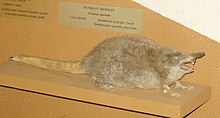
With its dense,lustrious coat,the Russian desman greatly resembles a water rat. Its tail is flattened for use as a rudder and paddle, and its rear feet are fully webbed, while the front feet are partially so. Using its long, sensitive nose, it searches for food at night in riverbeds.The Russian desman often lives in small (usually not related) groups of two to five animals, and appears to have a complex communication and social system.
Desman fur used to be highly sought after by the fur trade. Consequently, the Russian desman is now a protected species under Russian law. However, due to loss of habitat (farming), water pollution, illegal fishing nets, and the introduction of non-native species (e.g., muskrat), population levels continue to decline. In the mid-1970s, an estimated 70,000 desmans were left in the wild; by 2004, the figure was only 35,000. However, in some Russian regions, the number of desmans appears to be increasing.
No comments:
Post a Comment